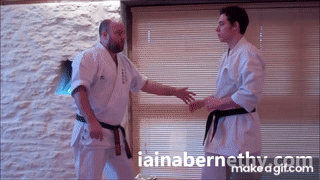The original way to perform the guarding block, as shown in General Choi's books, is to begin with the back hand high, near the ear, and the the front hand at blocking level, such that it moves in a horizontal line when executing the block.
 |
| Guarding block from Taekwon-Do: The Art of Self-Defense (1965) and The Encyclopedia of Taekwon-Do 2nd Ed (1987) |
 |
| The traditional use of the guarding block in action. Source: CrossFit |
(1) This is a defensive technique, not a "strike". Although pressing on the side of the opponent's neck is uncomfortable, the purpose is to control the opponent until the situation de-escalates. If it does not, then there are several follow-ups from this position.
(2) The motion of the back hand is an overhook, not a pull. The purpose is to hold the opponent's arm in close to your chest to prevent them from attacking you further.
(3) Notice that when the application is executed, you are 90-degrees from your opponent. Hence while the chamber seems to be performed to your side, in reality it is performed in the direction of the haymaker.
Two other applications
The downward motion of the back hand has other uses. Another common application is an underhook, performed by making the movement more circular. You may simultaneously use the front knifehand to push the opponent's head forward. If you manage to place the opponent's forearm onto your shoulder, you can lock their elbow, creating what's call a standing ude gatame in Judo.
 |
| Underhook/ude gatame application for the guarding block. Source: PracticalKataBunkai |
 |
| The circular guarding block performance, from the Encyclopedia of Taekwon-Do Vol 3 |
 |
| Source: Jesse Enkamp |
This post is an expansion on Ørjan Nilsen's article
No comments:
Post a Comment